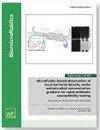微腔中稀有粒子/细胞的涡流分拣:综述
IF 2.4
4区 工程技术
Q2 BIOCHEMICAL RESEARCH METHODS
引用次数: 0
摘要
微流控或芯片实验室技术在从异质溶液中分离目标粒子/细胞方面显示出巨大的潜力。在目前的分离方法中,在微腔中对颗粒/细胞进行涡流分拣是一种非常有效的方法,可从流动样品中捕获和分离稀有的目标细胞,如循环肿瘤细胞。通过利用流体力和粒子惯性效应,这种被动方法具有无标记操作、高通量和高浓度等优点。本文回顾了这种方法中粒子聚焦、捕获和保持机制的基础研究、新型微腔的设计及其应用。我们还总结了该技术面临的挑战和前景,希望能促进其在医学和生物学研究中的应用。本文章由计算机程序翻译,如有差异,请以英文原文为准。
Vortex sorting of rare particles/cells in microcavities: A review
Microfluidics or lab-on-a-chip technology has shown great potential for the separation of target particles/cells from heterogeneous solutions. Among current separation methods, vortex sorting of particles/cells in microcavities is a highly effective method for trapping and isolating rare target cells, such as circulating tumor cells, from flowing samples. By utilizing fluid forces and inertial particle effects, this passive method offers advantages such as label-free operation, high throughput, and high concentration. This paper reviews the fundamental research on the mechanisms of focusing, trapping, and holding of particles in this method, designs of novel microcavities, as well as its applications. We also summarize the challenges and prospects of this technique with the hope to promote its applications in medical and biological research.
求助全文
通过发布文献求助,成功后即可免费获取论文全文。
去求助
来源期刊

Biomicrofluidics
生物-纳米科技
CiteScore
5.80
自引率
3.10%
发文量
68
审稿时长
1.3 months
期刊介绍:
Biomicrofluidics (BMF) is an online-only journal published by AIP Publishing to rapidly disseminate research in fundamental physicochemical mechanisms associated with microfluidic and nanofluidic phenomena. BMF also publishes research in unique microfluidic and nanofluidic techniques for diagnostic, medical, biological, pharmaceutical, environmental, and chemical applications.
BMF offers quick publication, multimedia capability, and worldwide circulation among academic, national, and industrial laboratories. With a primary focus on high-quality original research articles, BMF also organizes special sections that help explain and define specific challenges unique to the interdisciplinary field of biomicrofluidics.
Microfluidic and nanofluidic actuation (electrokinetics, acoustofluidics, optofluidics, capillary)
Liquid Biopsy (microRNA profiling, circulating tumor cell isolation, exosome isolation, circulating tumor DNA quantification)
Cell sorting, manipulation, and transfection (di/electrophoresis, magnetic beads, optical traps, electroporation)
Molecular Separation and Concentration (isotachophoresis, concentration polarization, di/electrophoresis, magnetic beads, nanoparticles)
Cell culture and analysis(single cell assays, stimuli response, stem cell transfection)
Genomic and proteomic analysis (rapid gene sequencing, DNA/protein/carbohydrate arrays)
Biosensors (immuno-assay, nucleic acid fluorescent assay, colorimetric assay, enzyme amplification, plasmonic and Raman nano-reporter, molecular beacon, FRET, aptamer, nanopore, optical fibers)
Biophysical transport and characterization (DNA, single protein, ion channel and membrane dynamics, cell motility and communication mechanisms, electrophysiology, patch clamping). Etc...
 求助内容:
求助内容: 应助结果提醒方式:
应助结果提醒方式:


